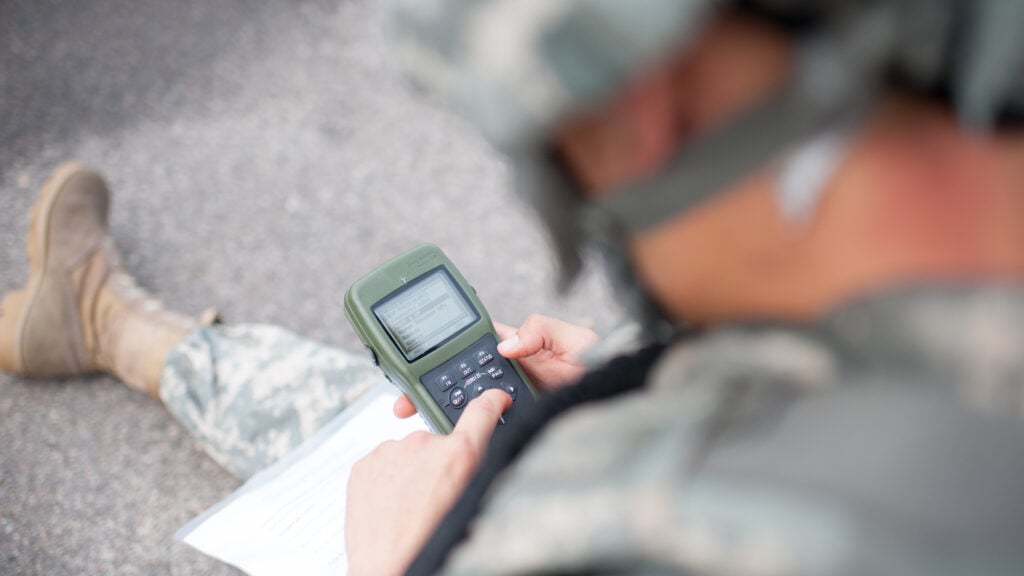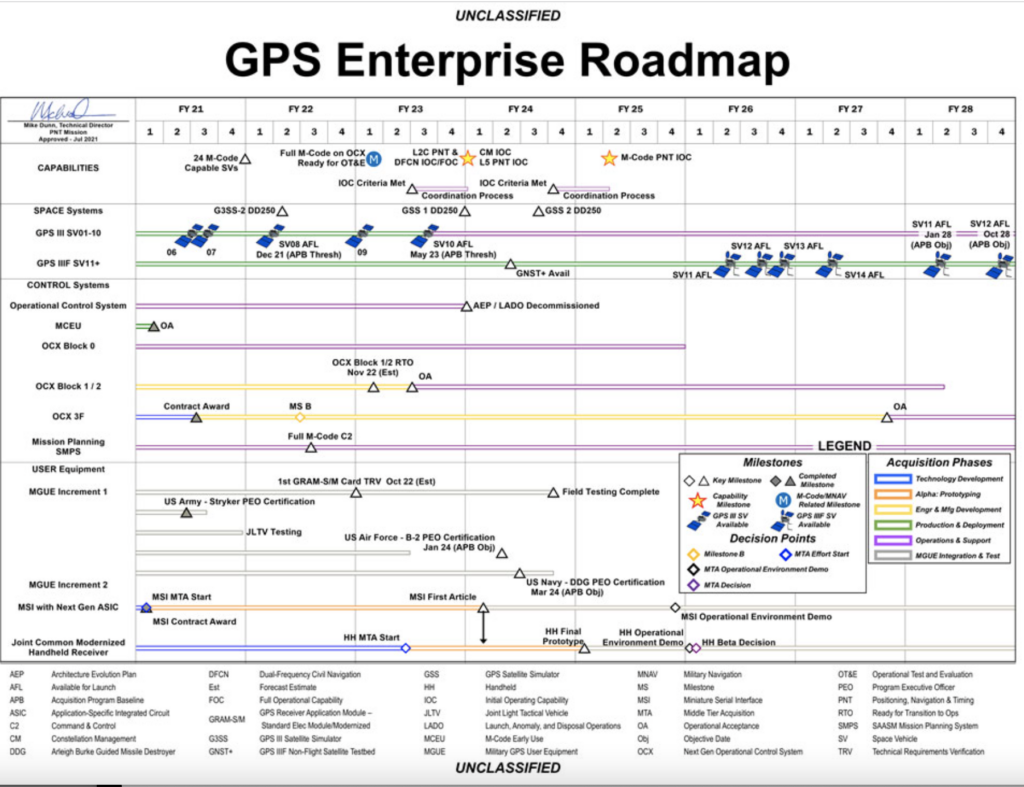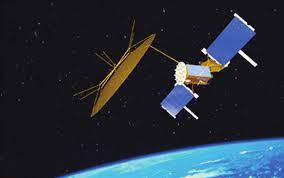
US Army Sgt. Brian Sunderman, a combat medic assigned to the 807th Medical Deployment Support Command, programs coordinates on a Defense Advanced GPS Receiver during the Urban Orienteering event in the 2013 Army Reserve Best Warrior Competition at Fort McCoy, Wis. (US Army photo by Timothy Hale)
WASHINGTON — Frank Calvelli, head of space acquisition for the Department of the Air Force, has made crystal clear over recent days his intent to resolve the long-standing problem of Pentagon satellites becoming operational years before ground equipment needed to use them is ready.
“It is the worst thing in the world to launch a spacecraft and not be able to use it, because you provided basically nothing at that point in time for the warfighter,” he told the GovConWire 2023 Acquisition Forum on Jan. 18. “I oversee the ground programs as well as the space programs. And I’ve been making that a priority that the ground needs to be there before launch. That has driven folks to do some creative things, like more incremental development on the ground.”
In particular, Calvelli is pledging to finally complete two of the most infamously delayed Space Force ground efforts: the software-based Next-Generation Operational Control System (OCX) for the new GPS III satellites; and the Military GPS User Equipment (MGUe) to provide radios capable of receiving the encrypted M-Code signal designed to avoid jamming.
“These albatrosses [have been] dragging the department down for decades. This is the year we are going to get these programs delivered,” he told the National Security Space Association’s Defense & Intelligence Space Conference on Jan. 24.
The phenomena of military satellites being able to call home long before anyone (or at least very few) can hear them is by no means new. The Government Accountability Office (GAO) in 2009 issued a detailed study looking at the systemic failure of Defense Department space programs to synchronize the deployment of satellites, ground control stations and mobile user terminals (i.e., receivers and radios).

Space Force 2022 GPS Enterprise Road Map
M-Code: Broadcasting, But To Whom?
The M-Code signal is a more powerful and encrypted signal to help military users overcome jamming and protect against false GPS signals being used to spoof users by misdirecting them. But the program to provide government-issued receivers is nearly two decades behind schedule.
Perhaps not coincidentally, 2009, the same year as the damning GAO report, was the year that M-Code originally was slated for initial operational capability (IOC) approval. The Space Forces January 2022 GPS Enterprise Road Map, first published by GPS World, shows IOC happening in the second quarter of fiscal 2025, a 16-year delay.
The 2021 annual report by the Pentagon’s Director of Operational Test & Evaluation found that due to the delays, the Army, Navy and Marines “have turned to commercially available, MGUE-derived M-code receivers to continue meeting PNT [position, navigation and timing] requirements. Those systems will undergo operational testing outside of the MGUE Increment 1 program of record.”
Meanwhile, the Space Force launched its sixth GPS III satellite, built by Lockheed Martin, on Jan. 18 — bringing the number of satellites able to broadcast the M-Code to 25.
The MGUE effort to receive M-Code has two tiers:
- MGUE Increment 1 to develop the baseline computer equipment (chips and cards) for initial integration with Army Strykers and Marine Corps Joint Light Tactical Vehicles, as well as for the Air Force’s B-2 bombers and the Navy’s DDG-class destroyers; and,
- MGUE Increment 2 to develop smaller, more modern equipment for newer kit, in particular the Joint Common Modernized Hand Held Receiver. Space Force provides the MGUE computer chips and cards to enable M-Code for users, while the individual services have to develop and fund the actual radio/receiver equipment for their weapon systems and personnel.
The GPS Enterprise Road Map shows field testing for Increment 1 being completed at the end of the third quarter in FY24. Increment 2, however, will remain in prototyping through the end of FY25.
OCX: Budget Cut The Latest Blow
Another reason the M-Code usage has fallen behind has been the interminable delay to OCX, a modern, software-based satellite control system that originally was specifically to handle the M-Code operations on the ground.
Being developed by Raytheon Technologies, OCX’s woes continue, with the most recent blow a budget cut of nearly $83 million in the FY23 omnibus appropriations act to the Space Force’s request of almost $360 million.
OCX has had a troubled history, to say the least — including a serious Nunn-McCurdy breach back in 2016 that drew the wrath of Frank Kendall, then DoD acquisition czar and now Air Force Secretary. OCX was originally supposed to become operational in the 2011-2012 timeframe.
“OCX Ready to Transition to Operations (RTO) milestone is projected no earlier than end of calendar year 2023. The program is also refining schedule estimates based on a substantial FY23 congressional budget cut and the further impacts this has on RTO and operational acceptance dates,” a Space Systems Command spokesperson told Breaking Defense in a email Wednesday.
The 2019 DoD Selected Acquisition Report [PDF] shows that in 2018, the expected RTO decision for OCX Block 1 and 2 had been set for April 2022. The 2022 DOT&E report sums up the GPS situation as follows:
“As was reported last year, full control of modernized civil and M-code signals and navigation warfare functions have continued to be delayed, due to ongoing development delays of the Next Generation Operational Control System (OCX), along with delays in the fielding of M-code capable receivers. These ongoing delays increase the risk that U.S. and allied warfighters will not be able to conduct operations with GPS-derived position, navigation, and time (PNT) information.”

Mobile User Objective System (MUOS) narrowband communications satellite (DOT&E image)
And Then There Is MUOS
As recently as 2021, GAO found that the DoD is unable to use the secure, ultra-high frequency (narrowband) Mobile User Objective System (MUOS) communications satellites because of lack of radios. Responsibility for MUOS was transferred from the Navy to the Air Force in May 2019, and subsequently to the Space Force when it stood up that December.
“The full constellation of MUOS satellites [five] has been on orbit for over 4 years, but DOD has not been able to use the system’s advanced capabilities — such as its 10-fold increase in communications capacity. A key reason is the military services’ delayed delivery of compatible radio terminals to users (see figure). DOD is funding and developing plans to accelerate procurement and delivery of these terminals,” the GAO report said.
The Space Force’s request for $46.8 million to buy two new MUOS satellites to meet current demand nonetheless was approved by congressional appropriators in the fiscal 2023 Omnibus Appropriations Act.
Fixing The Problem: Incremental Acquisition And ‘System-Of-Systems’ Integration?
“We’ve all been bitten by big, large ground programs,” Calvelli told the GovConWire conference. “They’re hard to do, these large monolithic ground systems.”
The question for DoD, and one that it could use industry help with, is how the military should take these large, traditionally monolithic ground systems and break them up into more manageable bite sized pieces that we could deliver quicker, he explained.
Kelly Hammett, head of the Space Rapid Capabilities Office, told the conference the same day that one of the big problems is a lack of “decision-making forums at lower levels for the system-of-systems” integration.
“We have a lot of authority within our own [Program Executive Officer] portfolios, our own programs, but we need to have system-of-systems engineering change board types of things, configuration control boards,” he said. “Questions were made about how do you connect various ground systems? We have no process for doing that currently.
“You know, if I want to change message formats, or interface standards for one of my systems that has to talk to [the Enterprise Ground Services] for example, what’s the process for that? Right now, we do what we want, they do what they want, and it ends up with stovepipe systems that don’t talk to each other,” he elaborated. “And so I can go really fast in my portfolio, but having the connective tissue once I’m done to the rest of the enterprise, and this applies to all the PEOs, is a really critical thing that we’re spending some important gray matter on right now.”
The Enterprise Ground Services effort is described by the Space Force’s FY23 budget documents as “a Government-owned ground architecture that focuses on Mission Management (MM), Telemetry, Tracking and Command (TT&C), and Ground Control (GC) utilizing common services.” The FY23 omnibus appropriations granted the Space Force its requested $123.6 million for the program.
Hammett said that in particular “there’s been a lot of discussion in my team and with the [Space Systems Integration Office] out of Space Systems Command” on the issue. The SSIO has been charged with implementing the Enterprise Ground Services architecture.
“So, we’re working through a lot of those details,” he said.
In a Taiwan conflict, tough choices could come for Big Tech
Washington could do more to incentivize tech companies to distance themselves from China, but CEOs should examine how they’d react to a fight in the Pacific, CSET’s Sam Bresnick and Emelia Probasco argue.


























